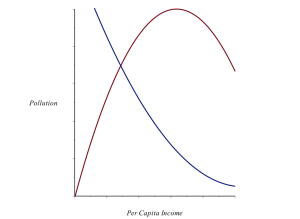Tweet [1]
As people grow wealthier, their demand for cleanliness and risk-reducing amenities increases. Cleanliness and risk-reducing amenities – amenities such as seat-belts in cars and safer workplaces – are what economists call “normal goods.” These are goods the demands for which change in the same direction as changes in consumers’ real incomes.
The fact that cleanliness and risk-reduction are normal goods helps to explain the shape of the environmental Kuznets curve [2]. This curve shows in a stylized way the relationship between per-capita income and industrial pollution. As a society, through greater industrialization and specialization and trade, moves from being one of only subsistence wealth to one of great wealth, industrial pollution at first increases and then starts to decrease. The logic is the following: when very poor people first begin to enjoy economic growth, they either don’t care very much about, or are unwilling to pay to abate, the increasing concentrations of industrial pollutants in the atmosphere. They prefer instead to take nearly all of the fruits of economic growth in the form of increased personal consumption options.
But as people grow even wealthier, the relative attractiveness to them of having a cleaner environment rises, so they devote more and more resources to pollution abatement. At some point people become so rich that the amounts of resources that they devote to pollution abatement is so great that pollution levels begin to fall. This account explains why the air in London and New York City today contains fewer of the industrial pollutants that were common to it in the late 19th and early 20th centuries.
As regular readers of Cafe Hayek know [3], I follow Julian Simon [4] in endorsing a broader conception of pollution. Pollution is not only the emissions of industrial processes. It is, more broadly, the presence in people’s environments of any physical matter that reduces people’s capacity to enjoy life. So, yes, the sulphur dioxide emitted from a factory’s smokestack into the surrounding air is pollution, but so too are the diarrhea-inducing bacteria in people’s food and the rodent droppings that fall from a thatched roof onto the heads of people living beneath it.
As I read history, people – as they start to grow wealthier beyond subsistence – do indeed seem willing at first to endure increasing levels of industrial pollutants, but they almost immediately spend resources to shield themselves from other kinds of pollutants – namely, the kinds of pollutants that are up-close, personal, and often of such lethality that these pollutants kill with great certainty within days or weeks rather only probabilistically over the course of years or decades.
I’m told by people with first-hand experience in sub-Saharan Africa that one of the first things that poor Africans buy when they get some little bit of wealth is soap. David Landes notes [5] that, at the dawn of the industrial revolution, among the first products of that revolution that was bought by the British masses was machine-woven underwear that could be vigorously washed. Even people very poor by the standards of modern America acquire dwellings with hard floors and roofs (as opposed to dirt-and-thresh floors and thatched roofs). Indoor plumbing seems to be an amenity that people do not wait long to get once their growing wealth brings this amenity into the range of what’s affordable.
In other words, my hypothesis – which I believe is borne out by the historical record – is that people almost immediately start to consume greater cleanliness as they become wealthier.
But – damn reality! – we continue to be plagued by trade-offs. The production of the wealth that allows people to begin early on in the economic-development process to rid themselves of many pollutants itself generates pollutants – specifically, those industrial pollutants that do not seem to start to be cleansed out of the atmosphere until some significant amount of sustained and widespread economic development has occurred.
 [6]
[6]
So I propose this amended version of the analysis. The red curve in the nearby graph is the standard environmental Kuznets curve. This red curve shows the relationship between per-capita income and industrial pollutants. The blue curve shows the relationship between per-capita income and what we might, as a short-hand, call “naturally occurring pollutants” (that is, filth such as bacteria, mud on indoor floors, and rodent and bird droppings from the ceiling of one’s home).
If I am correct in my reading of history that people almost from the start of economic development begin to reduce their exposure to naturally occurring pollutants, then even during that ‘stage’ of economic development when industrial pollutants are still increasing, it is incorrect to conclude that people’s environments necessarily are becoming more polluted. The decline in naturally occurring pollutants works in the opposite direction as the rise in industrial pollutants. The costs of the latter must be reckoned against the benefits of the former.
By the way, this amended analysis suggests that one possible reason why people early on in the economic-development process do not spend many resources on the abatement of industrial pollutants is that people care more about reducing their exposure to naturally occurring pollutants than they care about reducing their exposure to industrial pollutants. In other words, it is incorrect to argue that when people are still very poor they cannot afford pollution reduction or that they are still too poor to ‘care’ about reducing their exposure to pollution. The reason is that even very poor people, as soon as they can afford to do so, in fact purchase pollution abatement in the form of reduced exposure to naturally occurring pollutants.
….
I thank my son, Thomas, for his expert help in constructing the above graph. And thanks also to Sam Grove for his help in making the graph less cluttered.